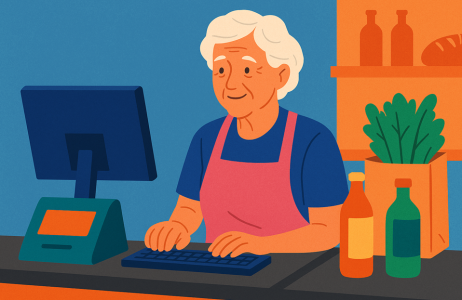Retired But Not Tired: Aussie Seniors Turn to Side Hustles to Boost Pensions
Australia’s image of retirement is changing. Instead of endless days of golf or knitting by the fire, more seniors are picking up a second job – and not just for the money. From bookkeepers to babysitters, tutors to tour guides, retirees are trading a bit of their leisure time for a paycheck (and maybe some fun on the side).
It’s a trend cropping up everywhere, and it’s driven by a mix of necessity and choice. Nearly a million Australians now work two or more jobs as the cost of living bites, according to recent ABS data. And yes, that includes plenty of over-60s who are stepping back into the workforce (or never left it to begin with).
In this article, we’ll dive into why so many older Australians are embracing “side hustles” to supplement their Age Pension or superannuation. We’ll look at the perks (extra cash, sense of purpose, social connections) and the challenges (health issues, age discrimination, plain old fatigue). Whether you’re 65 and considering a gig at the local Bunnings, or 75 and turning a hobby into a business, this one’s for you. Let’s explore the new reality of retirement work, and see if it’s your cup of tea.
“Retirement” isn’t what it used to be. Gone are the days when everyone hung up their work boots at 65 and went off to the caravan park. For one, the official Age Pension qualifying age in Australia has been creeping up – now 67 as of 2023 – which means people are both retiring later (average retirement age is around 63) and living longer.
With more years of life to fund and a longer wait for the pension, many over-60s are rethinking the no-work retirement. It’s no surprise that lots of seniors want to keep active in their community and earn extra money through part-time work.
Another big factor is the rising cost of living. We all feel the pinch at the petrol pump and supermarket checkout, but retirees on fixed incomes often feel it even more. Prices for essentials like food, utilities and petrol have climbed in recent years, and while pensions do get indexed, those increases can lag behind real inflation.
“Wage growth has not been matching the rate of inflation,” notes Professor Angela Knox from Sydney University, explaining why so many Australians (young and old) are picking up extra work. In fact, a record 986,400 Australians are holding down more than one job – about 6.6% of all workers – largely “driven by rising cost-of-living pressures”. For seniors, a modest “side hustle” can help ease financial stress while supporting the Age Pension. Every bit of extra income – whether it’s a shift at the local grocery or selling handmade crafts online – can make a difference when you’re on a pensioner’s budget.
But it’s not just about need. There’s also a positive story here: many older Australians are healthier and more energetic than ever, and they’re keen to stay engaged. Some actually enjoy work and dread the idea of endless leisure.
Jill Weeks, an Australian author and retirement expert, says the reasons people want to work after 60 vary widely. “The main reasons people want to work after 60 are to have something to do, to help with finances, because they don’t like retirement, for a chance to meet people, or a chance to learn new skills.” In other words, it’s not always just about the money – it can be about staying active, maintaining a sense of purpose, and keeping social.
Loneliness can creep in after leaving the workplace; a little job or volunteer gig can keep you connected to others. And learning the ropes of a new job or industry at 70 can be a thrilling challenge (who says you can’t learn new tricks?).
Let’s break down the motivations a bit more, starting with the dollars and cents. Financial pressure is undeniably a big driver. Australia’s Age Pension, while a crucial safety net, is modest and it assumes you have other savings or modest needs. If you’re only on the pension, covering rising costs in housing, groceries, and health care can be tough. The past couple of years saw high inflation (peaking around 7-8% in 2022) that outpaced pension increases. Many retirees saw their budgets squeezed.
For those with a bit of energy to spare, working a few hours a week can relieve that pressure. Experts note that cost-of-living increases have pushed people to seek extra income to pay the bills. It might be picking up a casual job (say, a couple of shifts at a retail store or café) or doing odd jobs in the gig economy.
In an ABC News report, one tradesman described “constantly chasing my tail with the bills” and turned to a second job painting houses just to cover basics. What used to be fun “pocket money” from a side gig is now going toward electricity and groceries. And it’s not just him – he observed mates doing everything from lawn-mowing to tip runs on weekends to make ends meet. That story is becoming familiar across the country.
Beyond inflation, some seniors didn’t get to accumulate much superannuation, especially women and those in physically demanding jobs. Remember, compulsory super started in 1992 – so a 70-year-old today spent a good chunk of their working life without mandatory employer super contributions.
Women in particular often had interrupted careers due to child-rearing or caring roles, resulting in much lower retirement savings. By the time they retire, women typically have about one-third less superannuation than men. That gap means older women, especially single women, are at higher risk of financial insecurity and may feel they need to keep earning a bit to feel comfortable. It’s one reason why we now see more older women in the workforce than before – in fact, 40% of new workers since the pandemic started are over 55, a statistic that underscores how many seniors (men and women) are rejoining the job market. Some are doing it out of necessity, others by choice – but it’s a striking figure.
Now, onto the non-financial motivations: as Jill Weeks noted, a lot of retirees simply want something meaningful to do. After decades of productive work life, it can be jarring to suddenly have nothing on the calendar. Many miss the routine, the camaraderie of colleagues, or the feeling of accomplishment after a day’s work. Picking up a part-time job or project can fill that void. It gives structure to the week – maybe you work every Tuesday and Thursday, for example – and that can make your leisure days feel sweeter too.
Seniors have told researchers they work to “have something to do” and because sometimes they “don’t like retirement” (the endless holiday isn’t for everyone). It can also be a chance to finally pursue a passion under the guise of work – for instance, someone who loved music might teach piano for a bit of income, or a former teacher might tutor migrant kids in English, finding joy and purpose in the activity.
There’s also the aspect of social interaction. The workplace, even if it’s just a few hours at the local library or volunteer center, can be a vital source of human connection. If you’ve ever chatted with the grandparent-aged greeter at Bunnings or the volunteer guide at a muscentreeum, you know they often have great enthusiasm for the role – it’s a way to meet people and feel useful. “
A chance to meet people” is indeed one reason to keep working after 60. Especially for those who might live alone or have lost a spouse, a job can combat isolation. And let’s be honest, some of us just thrive on being busy. Idleness can be depressing – staying busy (within one’s comfort limits) keeps the mind and body active.
When we talk about “second jobs” or “side hustles” for retirees, what kinds of work are we looking at? It turns out Aussie seniors are quite creative in this department. Many are rediscovering or repurposing skills from their former careers.
According to The Senior newspaper, people from office-based careers often find ways to “reshare their skills” in retirement – whether by doing some bookkeeping, copywriting, writing grant applications, or even sitting on boards. In other words, all those years of experience and knowledge don’t have to go to waste when you retire from full-time work.
A retired admin manager might do casual bookkeeping for local businesses. A former journalist might take up freelance writing or editing. Someone who managed a nonprofit could lend their expertise to another charity as a board member or grant writer. These kinds of roles can often be done on a very part-time or ad-hoc basis – perfect for a retiree’s schedule.
Working from home has also opened new doors. The pandemic normalised remote work and flexible gigs, and seniors have taken note. If you have a computer and an internet connection, there are opportunities to consult, freelance, or even teach from the comfort of home.
In fact, flexible arrangements have been a “primary motivation” for some retirees to resume working. Why not, if you can make a little income on your own terms? A 2023 seniors’ finance article lists “Freelance Writer” and “Online Teacher” as top work-from-home options for retirees, noting that older Australians can leverage their wealth of knowledge and stay mentally sharp by writing about subjects they know well or tutoring students online. We’ve heard of grandmas teaching English via Zoom to kids overseas, or grandpas doing online bookkeeping for family businesses – all in their slippers from the living room. It’s a brave new world!
Other popular gigs for the older crowd are those that can be done casually or seasonally. Think tour guiding, pet sitting, or babysitting. Love dogs but don’t want the commitment of owning one full-time? Becoming a part-time dog walker or pet sitter can be delightful (and pays surprisingly well per hour in some cases). Enjoy chatting with travelers? Some retirees become local tour guides, showing tourists around their city or region a few times a week – essentially getting paid to take a stroll and tell stories. If you don’t mind driving, delivery driving or rideshare can be an option; some seniors drive for Uber or deliver parcels, appreciating the flexible hours.
And let’s not forget the classic: the “grey army” of handymen and handywomen. Many semi-retired tradies or just DIY-savvy folks pick up odd jobs fixing things, doing gardening, or helping people move – either through word of mouth or platforms like Airtasker. It can be on your own time and often “you don’t need skills for” some of these odd jobs beyond reliability and elbow grease, as one Aussie observed of his friends picking up extra work.
There are also part-time roles in retail and hospitality where older workers shine. Customer-facing jobs can actually play to seniors’ strengths – life experience often brings patience and people skills. It’s not unusual now to see a retiree working a few shifts at the supermarket, the local café, or the bookstore. In fact, some major employers actively recruit seniors for their reliability and friendliness.
If you’re an early riser, a morning shift at a bakery could suit; if you love kids, helping out at a school canteen or as a teacher’s aide is another idea. (Schools often love mature staff and a large proportion of teacher’s aides are over 50 in Australiat) The beauty of being older is that you often know what you like and what you’re good at, so you can choose a side gig that fits your interests and energy level.
Let’s not forget starting a small business – the entrepreneurial bug can bite at any age. Some retirees turn hobbies into income: selling woodwork, artwork, or homemade jams at the weekend markets, for example. Others might start an online store or become a consultant in their field.
One story Jill Weeks shared was about a retired IT professional who started helping a friend install garden irrigation systems “for a few hours a week” which soon grew into many hours because he loved it. Another retiree with a manufacturing background kept getting called in to help old contacts, which blossomed into a “small business, ‘locum management’ (business babysitting)” with his wife – they became so popular that “we had trouble taking holidays” because everyone wanted their expertise! These anecdotes show that sometimes a “retirement gig” can snowball into a real second career – not that you have to let it consume your retirement, but it illustrates how valuable senior experience is in the marketplace.
Volunteering isn’t paid (by definition), but I’ll mention it here because it’s another avenue many retirees take to stay busy and engaged. For some, volunteering leads to paid opportunities later, or at least keeps skills sharp. Plus, it contributes to the community. Many organisations, from hospitals to museums, rely on senior volunteers. While it doesn’t boost your bank balance, it can boost your spirit – and sometimes that’s as important as dollars.
We’ve touched on some benefits already, but let’s highlight them clearly. The obvious perk of a second job in retirement is supplemental income – a bit of extra cash to top up the pension or stretch out the super savings. This can mean the difference between “just getting by” and feeling a bit more comfortable. It might fund a dinner out with friends each week, cover those ever-rising electricity bills, or help save up for a special trip or a gift for the grandkids. Having your “fun money” come from a side job can relieve guilt or worry about dipping into savings.
As one retiree put it, when his side gig painting houses was just for pocket money, he used it to indulge a hobby (his comic book collection); now that times are tighter, that same gig is helping with household bills. Either way, the extra income provides flexibility. And keep in mind, if you plan it right, you can often earn a certain amount without affecting your Age Pension – more on that in a bit.
Beyond money, a huge perk is staying active – mentally and physically. There’s plenty of evidence that engagement in work or purposeful activities can keep us sharper as we age. When you’re solving problems at work, learning new tasks, or even just moving around on the job, you’re using muscles (literal and figurative) that keep you healthy.
Contrast two scenarios: one person retires and spends most days on the couch watching daytime TV; another retires and a few days a week is out and about working or volunteering. It’s easy to see who might feel more vibrant and connected to the world. Work can also impose a bit of routine – you have to shower, dress, and show up somewhere on time. That routine can actually be good for mental health and preventing that aimless feeling some retirees get.
There’s also social capital. Work often means interacting with others – customers, coworkers, students, you name it. Those interactions can be energising. Even if you’re introverted, there’s value in feeling part of something beyond yourself. Many seniors enjoy multi-generational workplaces where they mix with younger colleagues; it can be refreshing and mutually beneficial (younger folks can help with tech tips, older folks mentor with life wisdom – a fair trade!).
One could argue that a bit of work keeps you young at heart. It forces you to keep learning (new technology, anyone?) and adapt to new situations, which is great for the brain. Some older workers say being around the younger generation at work gives them insight into modern life and even helps them stay culturally relevant – whether that’s learning what “TikTok” is or simply exchanging ideas.
Finally, there’s a sense of purpose and achievement that a job can provide. Even a small job can give you goals to meet, problems to solve, and the satisfaction of a job well done. That can do wonders for self-esteem. When someone asks “So, what are you up to these days?” you have a fun answer beyond “Oh, just puttering around.” You might say, “I actually work a couple days at the community garden nursery – it’s great, I get to teach people about plants,” or “I do bookkeeping for a friend’s business, keeps me busy.” It can feel rewarding to contribute skills and feel needed. As humans, we like to be useful. Retirement doesn’t switch that off for many people.
And let’s be honest – some of these side gigs can be enjoyable in their own right. If you choose something you like, it might not feel like work at all. Love driving? A few airport runs as an Uber driver might be fun (and you get to chat with passengers). Love kids? Babysitting the neighbour’s toddler occasionally might bring you joy (especially since you can give them back and go home to a quiet house after!).
Passionate about a cause? Earning a little stipend to coordinate events for a charity might be deeply fulfilling. Many seniors report that working in retirement gave them new friendships and a renewed sense of identity – they weren’t just retirees, they were also consultants, gardeners, teachers, coaches, etc. It added a new chapter to their life story.
You might be wondering, what about the Age Pension rules? Won’t earning extra money reduce your pension? This is an important consideration, and fortunately, the landscape has been shifting in favour of those who want to work a bit. The Australian government has recognised the value of senior workers and the reality that many pensioners want to earn extra income. In fact, there have been recent changes to make it easier for Age Pension recipients to have a job without losing their benefits.
One key policy is the Work Bonus. This is essentially an income allowance for pensioners – money you can earn from work that won’t be counted under the pension income test (which determines if your pension is reduced). Historically, the Work Bonus was $7,800 per year. But as of January 2024, it’s been boosted to $11,800 per year. In practical terms, this means you can earn up to $11,800 a year (around $453 per fortnight) from a job without it affecting your pension payments. That’s quite significant – over $4,000 more leeway than before.
The government also gave new pensioners a “boost” by adding $4,000 to their Work Bonus bank (a kind of balance that accumulates if you don’t use your full allowance) at the start of 2024. All these tweaks are “a clear sign from the government: they value your contribution to the workforce and want to make it easier for you to step back in if you choose.” In other words, the policy mood is very much pro-working-seniors at the moment.
Why is the government so keen? A couple of reasons. Workforce shortages in certain industries (like aged care, healthcare, agriculture) mean there’s a demand for workers that older Australians could help fill. National Seniors Australia, an advocacy group, has been urging the government to let willing pensioners work more without penalty, noting it could help alleviate worker shortfalls in critical sectors.
There’s an economic argument too: getting more over-65s into the labor force boosts the economy (a Deloitte analysis suggested even a 10% increase in senior workforce participation would give a substantial economic uptick). As the population ages, having more people remain economically active longer can take pressure off public finances and increase productivity. So it’s a win-win: seniors get more cash and purpose, and society gets their skills and labor.
Additionally, the Australian Bureau of Statistics has reported steady growth in workforce participation among older Australians – it jumped from about 11% in 2010 to 15% in 2021 for those 65 and over. By April 2021, some 619,000 older Australians (65+) were actively employed. This trend was happening even before the latest changes, but the policies are catching up to encourage it further.
Source: Sky News Australia/YouTube
The fact that roughly half of employed seniors work part-time and half full-time shows the diversity of how older Aussies engage with work – many choose reduced hours, but some do stick with full-time jobs into their late 60s and 70s.
It’s worth noting the government’s tone: they talk about “choice and flexibility” for older Australians to work. They’re careful to frame it as empowering those who want to work, not forcing anyone. As one government statement put it, “Giving older Australians the choice to engage in the workforce will not only benefit them by ensuring they keep more of their pension, it also benefits the nation.” So, if you’re an older Aussie reading this, rest assured no one is saying you must get a job – but if you do, the system is slowly adjusting to make sure you’re not penalized for it.
Of course, if you do earn well above that Work Bonus (nice problem to have!), your pension might be reduced under the income test. But that’s a bridge you can cross with Centrelink or a financial advisor’s guidance. The vast majority of side-hustling pensioners stay within the safe limits or only affect their pension minimally. And some retirees deliberately limit their hours to avoid crossing thresholds – for instance, working one day a week instead of two to remain under the cap. It’s about finding the sweet spot that works for you.
Now, before we all rush out to apply for jobs, let’s talk about the realities and challenges. Working in your 60s, 70s, even 80s is not going to be a walk in the park for everyone. There are some honest considerations to keep in mind:
Health and energy: First and foremost, not everyone can keep working due to health issues. Many manual laborers, for example, find their bodies simply give out by their 60s. An ABC News story recently highlighted a 66-year-old former builder named Ross whose body was “destroyed” after a lifetime of hard work – he hadn’t been able to work for four years and was struggling to hold out until pension age. “All us older guys, our bodies are worn out,” he said, arguing that people like him shouldn’t be expected to work into late 60s and that the pension age should be flexible for those in back-breaking careers.
This is a crucial point: if you’re in pain or have chronic health issues, a job might not be feasible or desirable. No side hustle is worth aggravating your health. So, the trend of working in retirement really applies mostly to those who are relatively fit and able. It’s wonderful to stay active, but listen to your body. Maybe a less physical job could work (say, consulting instead of lifting boxes) – but sometimes you truly need to rest, and that’s okay too.
Job availability and ageism: Another challenge can be actually finding a suitable job. Age discrimination is unfortunately a real thing. Some older Australians have shared stories of applying for jobs and not even getting an interview, suspecting their age was the barrier. “No one wants to employ me at my age,” is a sentiment we hear too often from frustrated older job seekers. While attitudes are slowly changing (and some industries actively seek seniors), it can take resilience to job-hunt in your later years.
A tip: look for senior-friendly employers or fields known to value experience. Networking can help – often retirees find gigs through people they know, rather than cold applications. Also consider the gig economy or self-employment where you’re essentially your own boss (freelancing, tutoring, consulting, etc.), which bypasses the traditional hiring bias.
Skill updates: Depending on how long you’ve been out of the workforce (or if you’re switching fields), there might be a learning curve. Technology, in particular, is a common hurdle. You might need to get up to speed with new software, or even just refresh your computer skills. The good news: there are courses and resources aimed at seniors to learn digital skills. And many workplaces will provide training.
But it’s something to be aware of – you’ll likely encounter new systems or ways of doing things. Approach it with a growth mindset (and maybe get a patient family member or friend to help you practice). Lifelong learning is part of the adventure.
Work-life balance: Funny to talk about work-life balance in retirement, but it’s true – you don’t want to overdo it. One could easily slip from a light side gig into essentially working almost full-time if not careful (especially if an employer sees you’re keen and starts offering more hours). Remember why you retired in the first place! Most seniors want the best of both worlds: some engagement and income, and the freedom to enjoy life. So it’s important to set boundaries.
Choose hours or days that still allow plenty of downtime, and be ready to say “no” if a side hustle threatens to take over your golden years. Burnout can happen at any age, and older bodies might take longer to recover from stress and fatigue. So, moderation is key.
Financial implications: While we covered the pension income rules being more lenient now, it’s still wise to keep an eye on the numbers. If you’re on any medication or have costs that come with concession cards, etc., make sure earning extra won’t inadvertently affect any benefits or tax situations. Most small earners won’t have to pay much extra tax, but once you earn above a certain threshold, you might have tax deducted from that second job at a higher rate (second jobs often are taxed at a different rate unless you adjust your withholding).
The ATO warns that extra income could bump you into a higher tax bracket or just mean you owe a bit at tax time. It’s not usually a deal-breaker, but it’s something to be aware of so you’re not caught by surprise. A chat with an accountant or using an online calculator can clarify the impact of earning, say, $5,000 or $10,000 more in a year.
Finally, emotional factors. Work can be stressful at times. Office politics, difficult customers, tight deadlines – those things don’t vanish just because you’re older. Some retirees step back into work and find it more tiring or frustrating than they remember (rose-tinted glasses of youth?). So it’s important to choose something that genuinely suits you now. Perhaps you loved managing big teams in your 40s; in your 70s, you might prefer something low-key with less responsibility.
On the other hand, some miss the thrill of big challenges and dive right back in – know thyself, as they say. The beauty of a side hustle in retirement is you ideally don’t have to endure a job you hate; you’re doing this by choice, so it should be enjoyable or at least satisfying. If it becomes a drag, you absolutely have the option to walk away – that freedom is something younger workers don’t always have (since they need the job to survive). So, empower yourself to trial different things. You might find that selling craft online wasn’t as fun as you thought, but volunteering at the community theater is fantastic – or vice versa. Retirement can be a time of discovery as much as any life stage.
All things considered, the rise of seniors taking on second jobs or side gigs is painting a more nuanced picture of modern retirement. It’s not all sunshine – the fact that some pensioners feel compelled to work due to cost pressures shows the challenges of living on a fixed income. There’s a valid conversation to be had about whether pensions should be higher, or whether it’s fair that people who’ve worked hard all their lives find themselves bagging groceries at 70 to afford rent.
At the same time, there’s an empowering narrative here: older Australians proving that age is just a number when it comes to contributing to society and pursuing goals. Many are finding joy, community, and financial ease through their post-retirement jobs. They’re mentors in workplaces, linchpins of charities, and even entrepreneurs launching ventures in their later years.
The key is choice. Not everyone can or should work in retirement – health, personal preference, and circumstances will dictate that. But it’s wonderful that opportunities exist for those who want to. In an ideal world, taking on a “second job” in your 60s or 70s isn’t an act of desperation, but an optional extra – a way to stay engaged and boost your lifestyle.
And indeed, for many it is exactly that: an option they’re happy to take. One could even argue this trend is redefining what it means to be “old.” When you see a 75-year-old running their own consulting business or a 68-year-old serving lattes at the cafe with a big smile, it challenges stereotypes about capability and vitality in later life.
It’s also fostering intergenerational understanding. Younger folks see their grandparents’ generation in a new light – as coworkers and fellow hustlers – and older folks get to experience aspects of the modern work culture (hello, digital apps and remote meetings) that keep them in the loop. Society benefits from the wisdom and work ethic of seniors, and seniors benefit from the inclusion and often the fun of being out there in the mix.
As we wrap up, it’s clear that the “golden years” are becoming, for some, a time of reinvention rather than just relaxation. You might call it a retirement renaissance or just a practical adjustment to 21st-century life. Is it for everyone? No. But the beauty now is that you have the choice to design your retirement your way.
Want to finally kick back and do nothing? Fair enough, you’ve earned it. Want to try your hand at a little business or job that tickles your fancy? The door’s open, and plenty of your peers are already inside, making it work.
So, what do you think? Would you trade a bit of your well-earned leisure for a second income or a new adventure in the workforce – or do you believe retirement should be strictly about relaxation? At the end of the day, what do you want your retirement to look like?
READ MORE: Freedom Behind the Gates: How ‘Dementia Villages’ Are Revolutionising Aged Care in Australia
It’s a trend cropping up everywhere, and it’s driven by a mix of necessity and choice. Nearly a million Australians now work two or more jobs as the cost of living bites, according to recent ABS data. And yes, that includes plenty of over-60s who are stepping back into the workforce (or never left it to begin with).
In this article, we’ll dive into why so many older Australians are embracing “side hustles” to supplement their Age Pension or superannuation. We’ll look at the perks (extra cash, sense of purpose, social connections) and the challenges (health issues, age discrimination, plain old fatigue). Whether you’re 65 and considering a gig at the local Bunnings, or 75 and turning a hobby into a business, this one’s for you. Let’s explore the new reality of retirement work, and see if it’s your cup of tea.
The New Reality of Retirement in Australia
“Retirement” isn’t what it used to be. Gone are the days when everyone hung up their work boots at 65 and went off to the caravan park. For one, the official Age Pension qualifying age in Australia has been creeping up – now 67 as of 2023 – which means people are both retiring later (average retirement age is around 63) and living longer.
With more years of life to fund and a longer wait for the pension, many over-60s are rethinking the no-work retirement. It’s no surprise that lots of seniors want to keep active in their community and earn extra money through part-time work.
Another big factor is the rising cost of living. We all feel the pinch at the petrol pump and supermarket checkout, but retirees on fixed incomes often feel it even more. Prices for essentials like food, utilities and petrol have climbed in recent years, and while pensions do get indexed, those increases can lag behind real inflation.
“Wage growth has not been matching the rate of inflation,” notes Professor Angela Knox from Sydney University, explaining why so many Australians (young and old) are picking up extra work. In fact, a record 986,400 Australians are holding down more than one job – about 6.6% of all workers – largely “driven by rising cost-of-living pressures”. For seniors, a modest “side hustle” can help ease financial stress while supporting the Age Pension. Every bit of extra income – whether it’s a shift at the local grocery or selling handmade crafts online – can make a difference when you’re on a pensioner’s budget.
But it’s not just about need. There’s also a positive story here: many older Australians are healthier and more energetic than ever, and they’re keen to stay engaged. Some actually enjoy work and dread the idea of endless leisure.
Jill Weeks, an Australian author and retirement expert, says the reasons people want to work after 60 vary widely. “The main reasons people want to work after 60 are to have something to do, to help with finances, because they don’t like retirement, for a chance to meet people, or a chance to learn new skills.” In other words, it’s not always just about the money – it can be about staying active, maintaining a sense of purpose, and keeping social.
Loneliness can creep in after leaving the workplace; a little job or volunteer gig can keep you connected to others. And learning the ropes of a new job or industry at 70 can be a thrilling challenge (who says you can’t learn new tricks?).
Why Some Seniors Are Clocking Back In
Let’s break down the motivations a bit more, starting with the dollars and cents. Financial pressure is undeniably a big driver. Australia’s Age Pension, while a crucial safety net, is modest and it assumes you have other savings or modest needs. If you’re only on the pension, covering rising costs in housing, groceries, and health care can be tough. The past couple of years saw high inflation (peaking around 7-8% in 2022) that outpaced pension increases. Many retirees saw their budgets squeezed.
For those with a bit of energy to spare, working a few hours a week can relieve that pressure. Experts note that cost-of-living increases have pushed people to seek extra income to pay the bills. It might be picking up a casual job (say, a couple of shifts at a retail store or café) or doing odd jobs in the gig economy.
In an ABC News report, one tradesman described “constantly chasing my tail with the bills” and turned to a second job painting houses just to cover basics. What used to be fun “pocket money” from a side gig is now going toward electricity and groceries. And it’s not just him – he observed mates doing everything from lawn-mowing to tip runs on weekends to make ends meet. That story is becoming familiar across the country.
Beyond inflation, some seniors didn’t get to accumulate much superannuation, especially women and those in physically demanding jobs. Remember, compulsory super started in 1992 – so a 70-year-old today spent a good chunk of their working life without mandatory employer super contributions.
Women in particular often had interrupted careers due to child-rearing or caring roles, resulting in much lower retirement savings. By the time they retire, women typically have about one-third less superannuation than men. That gap means older women, especially single women, are at higher risk of financial insecurity and may feel they need to keep earning a bit to feel comfortable. It’s one reason why we now see more older women in the workforce than before – in fact, 40% of new workers since the pandemic started are over 55, a statistic that underscores how many seniors (men and women) are rejoining the job market. Some are doing it out of necessity, others by choice – but it’s a striking figure.
Now, onto the non-financial motivations: as Jill Weeks noted, a lot of retirees simply want something meaningful to do. After decades of productive work life, it can be jarring to suddenly have nothing on the calendar. Many miss the routine, the camaraderie of colleagues, or the feeling of accomplishment after a day’s work. Picking up a part-time job or project can fill that void. It gives structure to the week – maybe you work every Tuesday and Thursday, for example – and that can make your leisure days feel sweeter too.
Seniors have told researchers they work to “have something to do” and because sometimes they “don’t like retirement” (the endless holiday isn’t for everyone). It can also be a chance to finally pursue a passion under the guise of work – for instance, someone who loved music might teach piano for a bit of income, or a former teacher might tutor migrant kids in English, finding joy and purpose in the activity.
There’s also the aspect of social interaction. The workplace, even if it’s just a few hours at the local library or volunteer center, can be a vital source of human connection. If you’ve ever chatted with the grandparent-aged greeter at Bunnings or the volunteer guide at a muscentreeum, you know they often have great enthusiasm for the role – it’s a way to meet people and feel useful. “
A chance to meet people” is indeed one reason to keep working after 60. Especially for those who might live alone or have lost a spouse, a job can combat isolation. And let’s be honest, some of us just thrive on being busy. Idleness can be depressing – staying busy (within one’s comfort limits) keeps the mind and body active.
Side Hustles and Second Careers: What Are Retirees Actually Doing?
When we talk about “second jobs” or “side hustles” for retirees, what kinds of work are we looking at? It turns out Aussie seniors are quite creative in this department. Many are rediscovering or repurposing skills from their former careers.
According to The Senior newspaper, people from office-based careers often find ways to “reshare their skills” in retirement – whether by doing some bookkeeping, copywriting, writing grant applications, or even sitting on boards. In other words, all those years of experience and knowledge don’t have to go to waste when you retire from full-time work.
A retired admin manager might do casual bookkeeping for local businesses. A former journalist might take up freelance writing or editing. Someone who managed a nonprofit could lend their expertise to another charity as a board member or grant writer. These kinds of roles can often be done on a very part-time or ad-hoc basis – perfect for a retiree’s schedule.
Working from home has also opened new doors. The pandemic normalised remote work and flexible gigs, and seniors have taken note. If you have a computer and an internet connection, there are opportunities to consult, freelance, or even teach from the comfort of home.
In fact, flexible arrangements have been a “primary motivation” for some retirees to resume working. Why not, if you can make a little income on your own terms? A 2023 seniors’ finance article lists “Freelance Writer” and “Online Teacher” as top work-from-home options for retirees, noting that older Australians can leverage their wealth of knowledge and stay mentally sharp by writing about subjects they know well or tutoring students online. We’ve heard of grandmas teaching English via Zoom to kids overseas, or grandpas doing online bookkeeping for family businesses – all in their slippers from the living room. It’s a brave new world!
Other popular gigs for the older crowd are those that can be done casually or seasonally. Think tour guiding, pet sitting, or babysitting. Love dogs but don’t want the commitment of owning one full-time? Becoming a part-time dog walker or pet sitter can be delightful (and pays surprisingly well per hour in some cases). Enjoy chatting with travelers? Some retirees become local tour guides, showing tourists around their city or region a few times a week – essentially getting paid to take a stroll and tell stories. If you don’t mind driving, delivery driving or rideshare can be an option; some seniors drive for Uber or deliver parcels, appreciating the flexible hours.
And let’s not forget the classic: the “grey army” of handymen and handywomen. Many semi-retired tradies or just DIY-savvy folks pick up odd jobs fixing things, doing gardening, or helping people move – either through word of mouth or platforms like Airtasker. It can be on your own time and often “you don’t need skills for” some of these odd jobs beyond reliability and elbow grease, as one Aussie observed of his friends picking up extra work.
There are also part-time roles in retail and hospitality where older workers shine. Customer-facing jobs can actually play to seniors’ strengths – life experience often brings patience and people skills. It’s not unusual now to see a retiree working a few shifts at the supermarket, the local café, or the bookstore. In fact, some major employers actively recruit seniors for their reliability and friendliness.
If you’re an early riser, a morning shift at a bakery could suit; if you love kids, helping out at a school canteen or as a teacher’s aide is another idea. (Schools often love mature staff and a large proportion of teacher’s aides are over 50 in Australiat) The beauty of being older is that you often know what you like and what you’re good at, so you can choose a side gig that fits your interests and energy level.
Let’s not forget starting a small business – the entrepreneurial bug can bite at any age. Some retirees turn hobbies into income: selling woodwork, artwork, or homemade jams at the weekend markets, for example. Others might start an online store or become a consultant in their field.
One story Jill Weeks shared was about a retired IT professional who started helping a friend install garden irrigation systems “for a few hours a week” which soon grew into many hours because he loved it. Another retiree with a manufacturing background kept getting called in to help old contacts, which blossomed into a “small business, ‘locum management’ (business babysitting)” with his wife – they became so popular that “we had trouble taking holidays” because everyone wanted their expertise! These anecdotes show that sometimes a “retirement gig” can snowball into a real second career – not that you have to let it consume your retirement, but it illustrates how valuable senior experience is in the marketplace.
Volunteering isn’t paid (by definition), but I’ll mention it here because it’s another avenue many retirees take to stay busy and engaged. For some, volunteering leads to paid opportunities later, or at least keeps skills sharp. Plus, it contributes to the community. Many organisations, from hospitals to museums, rely on senior volunteers. While it doesn’t boost your bank balance, it can boost your spirit – and sometimes that’s as important as dollars.
Perks of Working on the Side (It’s Not Just the Money)
We’ve touched on some benefits already, but let’s highlight them clearly. The obvious perk of a second job in retirement is supplemental income – a bit of extra cash to top up the pension or stretch out the super savings. This can mean the difference between “just getting by” and feeling a bit more comfortable. It might fund a dinner out with friends each week, cover those ever-rising electricity bills, or help save up for a special trip or a gift for the grandkids. Having your “fun money” come from a side job can relieve guilt or worry about dipping into savings.
As one retiree put it, when his side gig painting houses was just for pocket money, he used it to indulge a hobby (his comic book collection); now that times are tighter, that same gig is helping with household bills. Either way, the extra income provides flexibility. And keep in mind, if you plan it right, you can often earn a certain amount without affecting your Age Pension – more on that in a bit.
Beyond money, a huge perk is staying active – mentally and physically. There’s plenty of evidence that engagement in work or purposeful activities can keep us sharper as we age. When you’re solving problems at work, learning new tasks, or even just moving around on the job, you’re using muscles (literal and figurative) that keep you healthy.
Contrast two scenarios: one person retires and spends most days on the couch watching daytime TV; another retires and a few days a week is out and about working or volunteering. It’s easy to see who might feel more vibrant and connected to the world. Work can also impose a bit of routine – you have to shower, dress, and show up somewhere on time. That routine can actually be good for mental health and preventing that aimless feeling some retirees get.
There’s also social capital. Work often means interacting with others – customers, coworkers, students, you name it. Those interactions can be energising. Even if you’re introverted, there’s value in feeling part of something beyond yourself. Many seniors enjoy multi-generational workplaces where they mix with younger colleagues; it can be refreshing and mutually beneficial (younger folks can help with tech tips, older folks mentor with life wisdom – a fair trade!).
One could argue that a bit of work keeps you young at heart. It forces you to keep learning (new technology, anyone?) and adapt to new situations, which is great for the brain. Some older workers say being around the younger generation at work gives them insight into modern life and even helps them stay culturally relevant – whether that’s learning what “TikTok” is or simply exchanging ideas.
Finally, there’s a sense of purpose and achievement that a job can provide. Even a small job can give you goals to meet, problems to solve, and the satisfaction of a job well done. That can do wonders for self-esteem. When someone asks “So, what are you up to these days?” you have a fun answer beyond “Oh, just puttering around.” You might say, “I actually work a couple days at the community garden nursery – it’s great, I get to teach people about plants,” or “I do bookkeeping for a friend’s business, keeps me busy.” It can feel rewarding to contribute skills and feel needed. As humans, we like to be useful. Retirement doesn’t switch that off for many people.
And let’s be honest – some of these side gigs can be enjoyable in their own right. If you choose something you like, it might not feel like work at all. Love driving? A few airport runs as an Uber driver might be fun (and you get to chat with passengers). Love kids? Babysitting the neighbour’s toddler occasionally might bring you joy (especially since you can give them back and go home to a quiet house after!).
Passionate about a cause? Earning a little stipend to coordinate events for a charity might be deeply fulfilling. Many seniors report that working in retirement gave them new friendships and a renewed sense of identity – they weren’t just retirees, they were also consultants, gardeners, teachers, coaches, etc. It added a new chapter to their life story.
The Government’s Take: Encouraging Older Workers
You might be wondering, what about the Age Pension rules? Won’t earning extra money reduce your pension? This is an important consideration, and fortunately, the landscape has been shifting in favour of those who want to work a bit. The Australian government has recognised the value of senior workers and the reality that many pensioners want to earn extra income. In fact, there have been recent changes to make it easier for Age Pension recipients to have a job without losing their benefits.
One key policy is the Work Bonus. This is essentially an income allowance for pensioners – money you can earn from work that won’t be counted under the pension income test (which determines if your pension is reduced). Historically, the Work Bonus was $7,800 per year. But as of January 2024, it’s been boosted to $11,800 per year. In practical terms, this means you can earn up to $11,800 a year (around $453 per fortnight) from a job without it affecting your pension payments. That’s quite significant – over $4,000 more leeway than before.
The government also gave new pensioners a “boost” by adding $4,000 to their Work Bonus bank (a kind of balance that accumulates if you don’t use your full allowance) at the start of 2024. All these tweaks are “a clear sign from the government: they value your contribution to the workforce and want to make it easier for you to step back in if you choose.” In other words, the policy mood is very much pro-working-seniors at the moment.
Why is the government so keen? A couple of reasons. Workforce shortages in certain industries (like aged care, healthcare, agriculture) mean there’s a demand for workers that older Australians could help fill. National Seniors Australia, an advocacy group, has been urging the government to let willing pensioners work more without penalty, noting it could help alleviate worker shortfalls in critical sectors.
There’s an economic argument too: getting more over-65s into the labor force boosts the economy (a Deloitte analysis suggested even a 10% increase in senior workforce participation would give a substantial economic uptick). As the population ages, having more people remain economically active longer can take pressure off public finances and increase productivity. So it’s a win-win: seniors get more cash and purpose, and society gets their skills and labor.
Additionally, the Australian Bureau of Statistics has reported steady growth in workforce participation among older Australians – it jumped from about 11% in 2010 to 15% in 2021 for those 65 and over. By April 2021, some 619,000 older Australians (65+) were actively employed. This trend was happening even before the latest changes, but the policies are catching up to encourage it further.
Source: Sky News Australia/YouTube
The fact that roughly half of employed seniors work part-time and half full-time shows the diversity of how older Aussies engage with work – many choose reduced hours, but some do stick with full-time jobs into their late 60s and 70s.
It’s worth noting the government’s tone: they talk about “choice and flexibility” for older Australians to work. They’re careful to frame it as empowering those who want to work, not forcing anyone. As one government statement put it, “Giving older Australians the choice to engage in the workforce will not only benefit them by ensuring they keep more of their pension, it also benefits the nation.” So, if you’re an older Aussie reading this, rest assured no one is saying you must get a job – but if you do, the system is slowly adjusting to make sure you’re not penalized for it.
Of course, if you do earn well above that Work Bonus (nice problem to have!), your pension might be reduced under the income test. But that’s a bridge you can cross with Centrelink or a financial advisor’s guidance. The vast majority of side-hustling pensioners stay within the safe limits or only affect their pension minimally. And some retirees deliberately limit their hours to avoid crossing thresholds – for instance, working one day a week instead of two to remain under the cap. It’s about finding the sweet spot that works for you.
Considerations and Challenges (Keeping It Real)
Now, before we all rush out to apply for jobs, let’s talk about the realities and challenges. Working in your 60s, 70s, even 80s is not going to be a walk in the park for everyone. There are some honest considerations to keep in mind:
Health and energy: First and foremost, not everyone can keep working due to health issues. Many manual laborers, for example, find their bodies simply give out by their 60s. An ABC News story recently highlighted a 66-year-old former builder named Ross whose body was “destroyed” after a lifetime of hard work – he hadn’t been able to work for four years and was struggling to hold out until pension age. “All us older guys, our bodies are worn out,” he said, arguing that people like him shouldn’t be expected to work into late 60s and that the pension age should be flexible for those in back-breaking careers.
This is a crucial point: if you’re in pain or have chronic health issues, a job might not be feasible or desirable. No side hustle is worth aggravating your health. So, the trend of working in retirement really applies mostly to those who are relatively fit and able. It’s wonderful to stay active, but listen to your body. Maybe a less physical job could work (say, consulting instead of lifting boxes) – but sometimes you truly need to rest, and that’s okay too.
Job availability and ageism: Another challenge can be actually finding a suitable job. Age discrimination is unfortunately a real thing. Some older Australians have shared stories of applying for jobs and not even getting an interview, suspecting their age was the barrier. “No one wants to employ me at my age,” is a sentiment we hear too often from frustrated older job seekers. While attitudes are slowly changing (and some industries actively seek seniors), it can take resilience to job-hunt in your later years.
A tip: look for senior-friendly employers or fields known to value experience. Networking can help – often retirees find gigs through people they know, rather than cold applications. Also consider the gig economy or self-employment where you’re essentially your own boss (freelancing, tutoring, consulting, etc.), which bypasses the traditional hiring bias.
Skill updates: Depending on how long you’ve been out of the workforce (or if you’re switching fields), there might be a learning curve. Technology, in particular, is a common hurdle. You might need to get up to speed with new software, or even just refresh your computer skills. The good news: there are courses and resources aimed at seniors to learn digital skills. And many workplaces will provide training.
But it’s something to be aware of – you’ll likely encounter new systems or ways of doing things. Approach it with a growth mindset (and maybe get a patient family member or friend to help you practice). Lifelong learning is part of the adventure.
Work-life balance: Funny to talk about work-life balance in retirement, but it’s true – you don’t want to overdo it. One could easily slip from a light side gig into essentially working almost full-time if not careful (especially if an employer sees you’re keen and starts offering more hours). Remember why you retired in the first place! Most seniors want the best of both worlds: some engagement and income, and the freedom to enjoy life. So it’s important to set boundaries.
Choose hours or days that still allow plenty of downtime, and be ready to say “no” if a side hustle threatens to take over your golden years. Burnout can happen at any age, and older bodies might take longer to recover from stress and fatigue. So, moderation is key.
Financial implications: While we covered the pension income rules being more lenient now, it’s still wise to keep an eye on the numbers. If you’re on any medication or have costs that come with concession cards, etc., make sure earning extra won’t inadvertently affect any benefits or tax situations. Most small earners won’t have to pay much extra tax, but once you earn above a certain threshold, you might have tax deducted from that second job at a higher rate (second jobs often are taxed at a different rate unless you adjust your withholding).
The ATO warns that extra income could bump you into a higher tax bracket or just mean you owe a bit at tax time. It’s not usually a deal-breaker, but it’s something to be aware of so you’re not caught by surprise. A chat with an accountant or using an online calculator can clarify the impact of earning, say, $5,000 or $10,000 more in a year.
Finally, emotional factors. Work can be stressful at times. Office politics, difficult customers, tight deadlines – those things don’t vanish just because you’re older. Some retirees step back into work and find it more tiring or frustrating than they remember (rose-tinted glasses of youth?). So it’s important to choose something that genuinely suits you now. Perhaps you loved managing big teams in your 40s; in your 70s, you might prefer something low-key with less responsibility.
On the other hand, some miss the thrill of big challenges and dive right back in – know thyself, as they say. The beauty of a side hustle in retirement is you ideally don’t have to endure a job you hate; you’re doing this by choice, so it should be enjoyable or at least satisfying. If it becomes a drag, you absolutely have the option to walk away – that freedom is something younger workers don’t always have (since they need the job to survive). So, empower yourself to trial different things. You might find that selling craft online wasn’t as fun as you thought, but volunteering at the community theater is fantastic – or vice versa. Retirement can be a time of discovery as much as any life stage.
A New Chapter in the Golden Years
All things considered, the rise of seniors taking on second jobs or side gigs is painting a more nuanced picture of modern retirement. It’s not all sunshine – the fact that some pensioners feel compelled to work due to cost pressures shows the challenges of living on a fixed income. There’s a valid conversation to be had about whether pensions should be higher, or whether it’s fair that people who’ve worked hard all their lives find themselves bagging groceries at 70 to afford rent.
At the same time, there’s an empowering narrative here: older Australians proving that age is just a number when it comes to contributing to society and pursuing goals. Many are finding joy, community, and financial ease through their post-retirement jobs. They’re mentors in workplaces, linchpins of charities, and even entrepreneurs launching ventures in their later years.
The key is choice. Not everyone can or should work in retirement – health, personal preference, and circumstances will dictate that. But it’s wonderful that opportunities exist for those who want to. In an ideal world, taking on a “second job” in your 60s or 70s isn’t an act of desperation, but an optional extra – a way to stay engaged and boost your lifestyle.
And indeed, for many it is exactly that: an option they’re happy to take. One could even argue this trend is redefining what it means to be “old.” When you see a 75-year-old running their own consulting business or a 68-year-old serving lattes at the cafe with a big smile, it challenges stereotypes about capability and vitality in later life.
It’s also fostering intergenerational understanding. Younger folks see their grandparents’ generation in a new light – as coworkers and fellow hustlers – and older folks get to experience aspects of the modern work culture (hello, digital apps and remote meetings) that keep them in the loop. Society benefits from the wisdom and work ethic of seniors, and seniors benefit from the inclusion and often the fun of being out there in the mix.
As we wrap up, it’s clear that the “golden years” are becoming, for some, a time of reinvention rather than just relaxation. You might call it a retirement renaissance or just a practical adjustment to 21st-century life. Is it for everyone? No. But the beauty now is that you have the choice to design your retirement your way.
Want to finally kick back and do nothing? Fair enough, you’ve earned it. Want to try your hand at a little business or job that tickles your fancy? The door’s open, and plenty of your peers are already inside, making it work.
So, what do you think? Would you trade a bit of your well-earned leisure for a second income or a new adventure in the workforce – or do you believe retirement should be strictly about relaxation? At the end of the day, what do you want your retirement to look like?
READ MORE: Freedom Behind the Gates: How ‘Dementia Villages’ Are Revolutionising Aged Care in Australia













